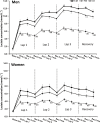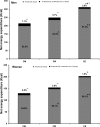Cardiovascular Fitness and Energy Expenditure Response during a Combined Aerobic and Circuit Weight Training Protocol
- PMID: 27832062
- PMCID: PMC5104360
- DOI: 10.1371/journal.pone.0164349
Cardiovascular Fitness and Energy Expenditure Response during a Combined Aerobic and Circuit Weight Training Protocol
Abstract
Objectives: The present study describes the oxygen uptake and total energy expenditure (including both aerobic and anaerobic contribution) response during three different circuit weight training (CWT) protocols of equivalent duration composed of free weight exercises, machine exercises, and a combination of free weight exercises intercalating aerobic exercise.
Design: Controlled, randomized crossover designs.
Methods: Subjects completed in a randomized order three circuit weight training protocols of the same duration (3 sets of 8 exercises, 45min 15s) and intensity (70% of 15 repetitions maximum). The circuit protocols were composed of free weight exercises, machine exercises, or a combination of free weight exercises with aerobic exercise. Oxygen consumption and lactate concentration were measured throughout the circuit to estimate aerobic and anaerobic energy expenditure respectively.
Results: Energy expenditure is higher in the combined exercise protocol (29.9±3.6 ml/kg/min), compared with Freeweight (24.2±2.8ml/kg/min) and Machine (20.4±2.9ml/kg/min). The combined exercise protocol produced the highest total energy expenditure but the lowest lactate concentration and perceived exertion. The anaerobic contribution to total energy expenditure was higher in the machine and free weight protocols compared with the combined exercise protocol (6.2%, 4.6% and 2.3% respectively).
Conclusions: In the proposed protocols, the combined exercise protocol results in the highest oxygen consumption. Total energy expenditure is related to the type of exercise included in the circuit. Anaerobic contributions to total energy expenditure during circuit weight training may be modest, but lack of their estimation may underestimate total energy expenditure.
Trial registration: ClinicalTrials.gov NCT01116856.
Conflict of interest statement
The authors have declared that no competing interests exist.
Figures



References
-
- Kodama S, Saito K, Tanaka S, Maki M, Yachi Y, Asumi M, et al. Cardiorespiratory fitness as a quantitative predictor of all-cause mortality and cardiovascular events in healthy men and women: a meta-analysis. JAMA. 2009;301(19):2024–35. Epub 2009/05/21. doi: 301/19/2024 [pii] 10.1001/jama.2009.681 . - DOI - PubMed
-
- U.S. Department of Health and Human Services. Physical activity guidelines for Americans. Okla Nurse [Internet]. 2008. 06/09/2015; 53(4):[25 p.]. Available from: http://health.gov/paguidelines/guidelines/. - PubMed
Publication types
MeSH terms
Substances
Associated data
LinkOut - more resources
Full Text Sources
Other Literature Sources
Medical

